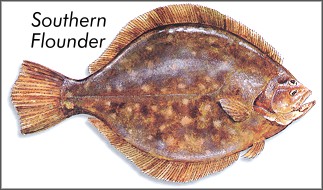 Flounders. This group includes the Southern Flounder, Gulf Flounder,
and Summer Flounder. Flounder eat mostly small fish, and bigger fish, and occasionally
shrimp. The most successful lure is one with a white grub-tail. So, use a fly that has a
thin grub-tail-type pattern. Use all white or white/orange or orange (Red Assassin in
white or orange). This is a slow retrieve, since flounder are predominately bottom
feeders.
Flounders. This group includes the Southern Flounder, Gulf Flounder,
and Summer Flounder. Flounder eat mostly small fish, and bigger fish, and occasionally
shrimp. The most successful lure is one with a white grub-tail. So, use a fly that has a
thin grub-tail-type pattern. Use all white or white/orange or orange (Red Assassin in
white or orange). This is a slow retrieve, since flounder are predominately bottom
feeders.
 Rod Busters. This group comprises the Great Barracuda (GO
CUDAS), Bluefish, Bonefish, Cobia, Dolphin, Tarpon, Tripletail, and Ladyfish. These
offshore and inshore predators are aggressive and will eat almost anything that comes
their way. This includes all baitfish, squid, shrimp, ballyhoo (mostly for barracuda),
mullet, small other species of game fish, pinfish, cigar minnows, grunts (pig fish), etc.
There are too many to name. Be sure to have at minimum 40# wire shock leader and
a lot of backing. These guys will strip off line faster than an electric drill. The retrieve
is fast and constant. Be prepared for one hell of a fight, as all these fish will tail walk.
A note of caution, be very careful boating these fish, they have sharp teeth and strong
bodies that can damage a boat and you!
Rod Busters. This group comprises the Great Barracuda (GO
CUDAS), Bluefish, Bonefish, Cobia, Dolphin, Tarpon, Tripletail, and Ladyfish. These
offshore and inshore predators are aggressive and will eat almost anything that comes
their way. This includes all baitfish, squid, shrimp, ballyhoo (mostly for barracuda),
mullet, small other species of game fish, pinfish, cigar minnows, grunts (pig fish), etc.
There are too many to name. Be sure to have at minimum 40# wire shock leader and
a lot of backing. These guys will strip off line faster than an electric drill. The retrieve
is fast and constant. Be prepared for one hell of a fight, as all these fish will tail walk.
A note of caution, be very careful boating these fish, they have sharp teeth and strong
bodies that can damage a boat and you!
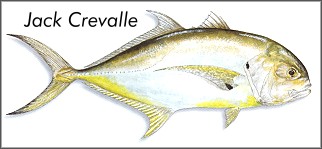 Jacks. Jacks include the notorious Cravalle, Blue Runner, Bar
Jack, Yellow Jack, Horse-eye Jack, Rainbow Runner, Leatherjack, Pilotfish, Greater
Amberjack, Lesser Amberjack, Almaco Jack, Banded Rudderfish, Florida Pompano,
Permit, Palometa, African Pompano and Lookdown. Jacks will eat almost anything,
even my friend's old sock once. In a schooled frenzy chasing down baitfish the
characteristic is recognizable. You'll see bait fish airborne above the water trying to
escape the powerful jaws of the jack. Jacks are very, very fast and powerful. They
give the fly rodder something to remember. The retrieve is fast with the exception of
the Permit. Permit eat crabs. They are basically bottom feeders. Also, Pompano like
to bottom feed as well. They will eat sand fleas (sand crabs), fiddler crabs, clams and
sea worms. Bonefish flies and large crab imitations work well. Pompano will out race
and out pull a jack Cravelle of the same size. Again adjust your strip for the game fish
of choice and have enough backing.
Jacks. Jacks include the notorious Cravalle, Blue Runner, Bar
Jack, Yellow Jack, Horse-eye Jack, Rainbow Runner, Leatherjack, Pilotfish, Greater
Amberjack, Lesser Amberjack, Almaco Jack, Banded Rudderfish, Florida Pompano,
Permit, Palometa, African Pompano and Lookdown. Jacks will eat almost anything,
even my friend's old sock once. In a schooled frenzy chasing down baitfish the
characteristic is recognizable. You'll see bait fish airborne above the water trying to
escape the powerful jaws of the jack. Jacks are very, very fast and powerful. They
give the fly rodder something to remember. The retrieve is fast with the exception of
the Permit. Permit eat crabs. They are basically bottom feeders. Also, Pompano like
to bottom feed as well. They will eat sand fleas (sand crabs), fiddler crabs, clams and
sea worms. Bonefish flies and large crab imitations work well. Pompano will out race
and out pull a jack Cravelle of the same size. Again adjust your strip for the game fish
of choice and have enough backing.
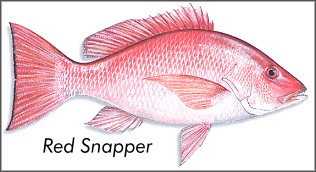 Snappers. Snappers are a large group consisting of the Mangrove
or Mango, Red, Mutton, Lane, Cubera, Dog, Schoolmaster, Yellowtail, Vermillion,
Mahogany, Blackfin, Silk and Queen Snapper. Snappers eat pilchards, cigar minnows
and squid. They have been known to take a liking to pink squid flies with buck tail.
Snappers must be coaxed up and then cast and retrieve is fast, pause, fast, and pause.
The exception is the mangrove or gray snapper that can be caught in the inshore estuaries.
The retrieve is fast, slow, fast, and slow.
Snappers. Snappers are a large group consisting of the Mangrove
or Mango, Red, Mutton, Lane, Cubera, Dog, Schoolmaster, Yellowtail, Vermillion,
Mahogany, Blackfin, Silk and Queen Snapper. Snappers eat pilchards, cigar minnows
and squid. They have been known to take a liking to pink squid flies with buck tail.
Snappers must be coaxed up and then cast and retrieve is fast, pause, fast, and pause.
The exception is the mangrove or gray snapper that can be caught in the inshore estuaries.
The retrieve is fast, slow, fast, and slow.
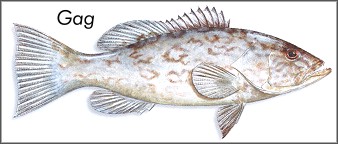 Groupers. All coasts of Florida are home to the groupers. They
are standard table fare at most restaurants and in little danger of extinction. Most
groupers are bottom dwellers and live in very deep water. However, some of the
smaller groupers make it up the Inter-Coastal Waterway and the inshore rivers along
both coasts. The most common, locally, caught on fly rod are the Gag, Black Grouper,
and Black Sea Bass. The Sand Perch Grouper is often lunch for the other groupers as
well as pilchards, anchovy, herring, pinfish, mullet, grunts and cut baits. Incidentally,
we are talking about rod weights in the 12-wt to 15-wt class. Groupers are big, strong
and powerful and can weigh in excess of 50 pounds. One hundred pounds is not
uncommon. Once chummed to the surface, grouper will hit big pilchard flies 3/0 up
to 7/0. The retrieve is medium to fast.
Groupers. All coasts of Florida are home to the groupers. They
are standard table fare at most restaurants and in little danger of extinction. Most
groupers are bottom dwellers and live in very deep water. However, some of the
smaller groupers make it up the Inter-Coastal Waterway and the inshore rivers along
both coasts. The most common, locally, caught on fly rod are the Gag, Black Grouper,
and Black Sea Bass. The Sand Perch Grouper is often lunch for the other groupers as
well as pilchards, anchovy, herring, pinfish, mullet, grunts and cut baits. Incidentally,
we are talking about rod weights in the 12-wt to 15-wt class. Groupers are big, strong
and powerful and can weigh in excess of 50 pounds. One hundred pounds is not
uncommon. Once chummed to the surface, grouper will hit big pilchard flies 3/0 up
to 7/0. The retrieve is medium to fast.
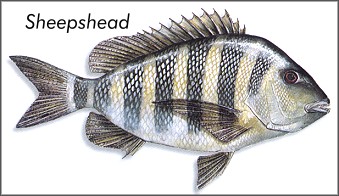 The Porgies. Porgies include Sheepshead, Pinfish, Spottail Pinfish,
Silver Porgy, Sea Bream, Grass Porgy, Whitebone Porgy, Jolthead Porgy, Saucereye
Porgy, and Red Porgy. Without exception they all love shrimp and shellfish including
sand and fiddler crabs and an occasional decorator crab (see picture). I recommend
round hook-tied flies. Setting the hook on Sheepshead is difficult. A round hook will
set itself. The retrieve is moderate to fast. Pinfish and the other porgies love shrimp.
You'll notice these fish are also bait for most of the predators discussed here. A Borski
Slider or Bay Shrimp in sizes #2 to 1/0 work well. Retrieve is slow to medium.
The Porgies. Porgies include Sheepshead, Pinfish, Spottail Pinfish,
Silver Porgy, Sea Bream, Grass Porgy, Whitebone Porgy, Jolthead Porgy, Saucereye
Porgy, and Red Porgy. Without exception they all love shrimp and shellfish including
sand and fiddler crabs and an occasional decorator crab (see picture). I recommend
round hook-tied flies. Setting the hook on Sheepshead is difficult. A round hook will
set itself. The retrieve is moderate to fast. Pinfish and the other porgies love shrimp.
You'll notice these fish are also bait for most of the predators discussed here. A Borski
Slider or Bay Shrimp in sizes #2 to 1/0 work well. Retrieve is slow to medium.
The Grunts. Grunts include the Pigfish, White Grunt, Margate,
Bluestriped Grunt, French Grunt, Tomtate, Black Margate, and Porkfish. The only
one of any consequence is the Pigfish since this is a staple of spotted seatrout. Grunts
are scavengers and will eat anything lying on the bottom. I don't know anyone who
fly-fishes for Grunts.
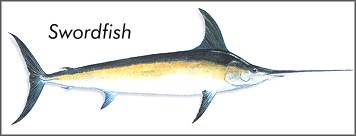 Billfish. This is the big water group of Swordfish, Blue Marlin, White
Marlin, Hatchet Marlin, Longbill Spearfish and Sailfish. These big boys will eat dolphin,
mackeral, mullet, ballyhoo, bonito and any other large baitfish. These monsters will weigh
up to 500 pounds and take special fly-fishing rigging to land. This is an activity for only
expert fly anglers. The retrieve is fast and the fight exhausting.
Billfish. This is the big water group of Swordfish, Blue Marlin, White
Marlin, Hatchet Marlin, Longbill Spearfish and Sailfish. These big boys will eat dolphin,
mackeral, mullet, ballyhoo, bonito and any other large baitfish. These monsters will weigh
up to 500 pounds and take special fly-fishing rigging to land. This is an activity for only
expert fly anglers. The retrieve is fast and the fight exhausting.
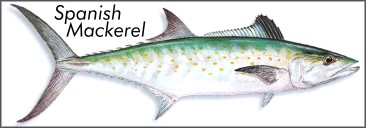 Mackerels and Tunas. The grouping includes mostly offshore species
of Wahoo, King and Spanish Mackerel, Cero, Frigate Mackerel, all the Tunas, Bonito,
and Albacore. Of this group only the Spanish Mackerel is a coastal fish that sometimes
roams offshore. Spanish M's are fast runners, tail walkers, blasting out of the water, doing
flips, and just doing anything to lose a hook. They are great fighters on a fly rod. The
best flies will have a lot of flash and imitate small silvery baitfish. The retrieve is fast.
Mackerels and Tunas. The grouping includes mostly offshore species
of Wahoo, King and Spanish Mackerel, Cero, Frigate Mackerel, all the Tunas, Bonito,
and Albacore. Of this group only the Spanish Mackerel is a coastal fish that sometimes
roams offshore. Spanish M's are fast runners, tail walkers, blasting out of the water, doing
flips, and just doing anything to lose a hook. They are great fighters on a fly rod. The
best flies will have a lot of flash and imitate small silvery baitfish. The retrieve is fast.
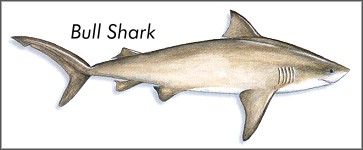 Sharks. This group includes all the Hammerheads, Bonnethead, Reef,
Tiger, Blacktip, Sandbar, Dusky, Bull, Whitetip, Silky, Spinner, Lemon, Sharpnose, Nurse,
Thresher, Shortfin Mako, and White Shark. Most bays and estuaries are home to many
species of sharks including hammerheads, dusky, lemon, nurse, and bull sharks. The
inshore areas are nurseries for juvenile sharks in the four to six foot range. They are
voracious feeders and do not like to be hooked. Their favorite food is the Southern
Sting Ray and Clearnose Skate. Lemon sharks especially love rays. You can see them
chasing rays down in the surf in very shallow water. All of which are common throughout
Mosquito Lagoon and the Indian River. They will take almost any type of fly if it lands
within their sight or in a feeding area. The Bull Shark lives in the coastal range and has
been caught well inland in freshwater rivers and creeks. The retrieve is fast, slow, sink,
fast, slow, sink. The best way to land a shark is to sight fish for them. Use a shark fly
in orange bucktail on a 3/0 hook.
Sharks. This group includes all the Hammerheads, Bonnethead, Reef,
Tiger, Blacktip, Sandbar, Dusky, Bull, Whitetip, Silky, Spinner, Lemon, Sharpnose, Nurse,
Thresher, Shortfin Mako, and White Shark. Most bays and estuaries are home to many
species of sharks including hammerheads, dusky, lemon, nurse, and bull sharks. The
inshore areas are nurseries for juvenile sharks in the four to six foot range. They are
voracious feeders and do not like to be hooked. Their favorite food is the Southern
Sting Ray and Clearnose Skate. Lemon sharks especially love rays. You can see them
chasing rays down in the surf in very shallow water. All of which are common throughout
Mosquito Lagoon and the Indian River. They will take almost any type of fly if it lands
within their sight or in a feeding area. The Bull Shark lives in the coastal range and has
been caught well inland in freshwater rivers and creeks. The retrieve is fast, slow, sink,
fast, slow, sink. The best way to land a shark is to sight fish for them. Use a shark fly
in orange bucktail on a 3/0 hook.
The best retrieve is the one that works for you. Just remember to let that fly settle before you start
stripping. Now go out and fool some fish. ~ Doug
About Doug:
Capt. Doug Sinclair has relocated from New Smyrna Beach, Florida to
Grantsboro, NC. He specializes in fly-fishing and light tackle charters.
Doug charters the Coastal Carolina area of New Bern or Oriental.
Catch him on the web at
www.flyfishacademy.net or call him at (252) 745-3500.
Doug is also a Sponsor here on FAOL.
Special credit for the fish illustrations from: Sport Fish of
Florida published by the Florida Sportsman.

 Croakers. These include Spotted Seatrout, Weakfish, Sand Seatrout,
Silver Seatrout, Red Drum, Black Drum, Atlantic Croaker, Silver Perch, Spot, Northern
Kingfish, Southern Kingfish, and Gulf Kingfish. For you spinning tackle guys we
recommend still fishing because the bait these fish consume will be walking, crawling
or scurrying away on the bottom. You've guessed it; this is a short, slow retrieve.
The fly has to get to the bottom or at least near the bottom. An ideal situation is to
sight cast the fish and let the fly sink. Yes. "Let it sink." For Spotted Seatrout the
best approach is to cast to a white hole (a spot bare of sea grass) and bring the fly to
the edge and let it drop. Move the fly the tiniest bit (3-inch strip) and let it settle back
down. Repeat this and let me know how big that trout weighed. The best flies for
Spotted Seatrout include the White Snookzit, Kelly spoonfly (salmon color), Silver
Dupre Spoonfly, Salty Bugger and any shrimp or pigfish imitation.
Croakers. These include Spotted Seatrout, Weakfish, Sand Seatrout,
Silver Seatrout, Red Drum, Black Drum, Atlantic Croaker, Silver Perch, Spot, Northern
Kingfish, Southern Kingfish, and Gulf Kingfish. For you spinning tackle guys we
recommend still fishing because the bait these fish consume will be walking, crawling
or scurrying away on the bottom. You've guessed it; this is a short, slow retrieve.
The fly has to get to the bottom or at least near the bottom. An ideal situation is to
sight cast the fish and let the fly sink. Yes. "Let it sink." For Spotted Seatrout the
best approach is to cast to a white hole (a spot bare of sea grass) and bring the fly to
the edge and let it drop. Move the fly the tiniest bit (3-inch strip) and let it settle back
down. Repeat this and let me know how big that trout weighed. The best flies for
Spotted Seatrout include the White Snookzit, Kelly spoonfly (salmon color), Silver
Dupre Spoonfly, Salty Bugger and any shrimp or pigfish imitation. Flounders. This group includes the Southern Flounder, Gulf Flounder,
and Summer Flounder. Flounder eat mostly small fish, and bigger fish, and occasionally
shrimp. The most successful lure is one with a white grub-tail. So, use a fly that has a
thin grub-tail-type pattern. Use all white or white/orange or orange (Red Assassin in
white or orange). This is a slow retrieve, since flounder are predominately bottom
feeders.
Flounders. This group includes the Southern Flounder, Gulf Flounder,
and Summer Flounder. Flounder eat mostly small fish, and bigger fish, and occasionally
shrimp. The most successful lure is one with a white grub-tail. So, use a fly that has a
thin grub-tail-type pattern. Use all white or white/orange or orange (Red Assassin in
white or orange). This is a slow retrieve, since flounder are predominately bottom
feeders.
 Snook. These are Common Snook, Fat Snook, Swordspine Snook,
and Tarpon Snook. Snook love baitfish such as pilchards or mullet. They will also take
shrimp and crabs. They are best fishing in the late afternoon around bridges, docks and
mangrove lines where they can ambush small fish. Top water flies work best such as
Ultra Hair Bugs, Inverted Mullet, Wool Head Mullet, Snookzit, and other top-water
pushing flies. The stripping action is fast, slow, fast, and slow. Get the fly moving so
it makes a pulsating motion in the water. Popper flies also work well and these can be
stripped using a fast, twitch, slow, twitch that makes a top water darting motion.
Snook. These are Common Snook, Fat Snook, Swordspine Snook,
and Tarpon Snook. Snook love baitfish such as pilchards or mullet. They will also take
shrimp and crabs. They are best fishing in the late afternoon around bridges, docks and
mangrove lines where they can ambush small fish. Top water flies work best such as
Ultra Hair Bugs, Inverted Mullet, Wool Head Mullet, Snookzit, and other top-water
pushing flies. The stripping action is fast, slow, fast, and slow. Get the fly moving so
it makes a pulsating motion in the water. Popper flies also work well and these can be
stripped using a fast, twitch, slow, twitch that makes a top water darting motion. Rod Busters. This group comprises the Great Barracuda (GO
CUDAS), Bluefish, Bonefish, Cobia, Dolphin, Tarpon, Tripletail, and Ladyfish. These
offshore and inshore predators are aggressive and will eat almost anything that comes
their way. This includes all baitfish, squid, shrimp, ballyhoo (mostly for barracuda),
mullet, small other species of game fish, pinfish, cigar minnows, grunts (pig fish), etc.
There are too many to name. Be sure to have at minimum 40# wire shock leader and
a lot of backing. These guys will strip off line faster than an electric drill. The retrieve
is fast and constant. Be prepared for one hell of a fight, as all these fish will tail walk.
A note of caution, be very careful boating these fish, they have sharp teeth and strong
bodies that can damage a boat and you!
Rod Busters. This group comprises the Great Barracuda (GO
CUDAS), Bluefish, Bonefish, Cobia, Dolphin, Tarpon, Tripletail, and Ladyfish. These
offshore and inshore predators are aggressive and will eat almost anything that comes
their way. This includes all baitfish, squid, shrimp, ballyhoo (mostly for barracuda),
mullet, small other species of game fish, pinfish, cigar minnows, grunts (pig fish), etc.
There are too many to name. Be sure to have at minimum 40# wire shock leader and
a lot of backing. These guys will strip off line faster than an electric drill. The retrieve
is fast and constant. Be prepared for one hell of a fight, as all these fish will tail walk.
A note of caution, be very careful boating these fish, they have sharp teeth and strong
bodies that can damage a boat and you! Jacks. Jacks include the notorious Cravalle, Blue Runner, Bar
Jack, Yellow Jack, Horse-eye Jack, Rainbow Runner, Leatherjack, Pilotfish, Greater
Amberjack, Lesser Amberjack, Almaco Jack, Banded Rudderfish, Florida Pompano,
Permit, Palometa, African Pompano and Lookdown. Jacks will eat almost anything,
even my friend's old sock once. In a schooled frenzy chasing down baitfish the
characteristic is recognizable. You'll see bait fish airborne above the water trying to
escape the powerful jaws of the jack. Jacks are very, very fast and powerful. They
give the fly rodder something to remember. The retrieve is fast with the exception of
the Permit. Permit eat crabs. They are basically bottom feeders. Also, Pompano like
to bottom feed as well. They will eat sand fleas (sand crabs), fiddler crabs, clams and
sea worms. Bonefish flies and large crab imitations work well. Pompano will out race
and out pull a jack Cravelle of the same size. Again adjust your strip for the game fish
of choice and have enough backing.
Jacks. Jacks include the notorious Cravalle, Blue Runner, Bar
Jack, Yellow Jack, Horse-eye Jack, Rainbow Runner, Leatherjack, Pilotfish, Greater
Amberjack, Lesser Amberjack, Almaco Jack, Banded Rudderfish, Florida Pompano,
Permit, Palometa, African Pompano and Lookdown. Jacks will eat almost anything,
even my friend's old sock once. In a schooled frenzy chasing down baitfish the
characteristic is recognizable. You'll see bait fish airborne above the water trying to
escape the powerful jaws of the jack. Jacks are very, very fast and powerful. They
give the fly rodder something to remember. The retrieve is fast with the exception of
the Permit. Permit eat crabs. They are basically bottom feeders. Also, Pompano like
to bottom feed as well. They will eat sand fleas (sand crabs), fiddler crabs, clams and
sea worms. Bonefish flies and large crab imitations work well. Pompano will out race
and out pull a jack Cravelle of the same size. Again adjust your strip for the game fish
of choice and have enough backing. Snappers. Snappers are a large group consisting of the Mangrove
or Mango, Red, Mutton, Lane, Cubera, Dog, Schoolmaster, Yellowtail, Vermillion,
Mahogany, Blackfin, Silk and Queen Snapper. Snappers eat pilchards, cigar minnows
and squid. They have been known to take a liking to pink squid flies with buck tail.
Snappers must be coaxed up and then cast and retrieve is fast, pause, fast, and pause.
The exception is the mangrove or gray snapper that can be caught in the inshore estuaries.
The retrieve is fast, slow, fast, and slow.
Snappers. Snappers are a large group consisting of the Mangrove
or Mango, Red, Mutton, Lane, Cubera, Dog, Schoolmaster, Yellowtail, Vermillion,
Mahogany, Blackfin, Silk and Queen Snapper. Snappers eat pilchards, cigar minnows
and squid. They have been known to take a liking to pink squid flies with buck tail.
Snappers must be coaxed up and then cast and retrieve is fast, pause, fast, and pause.
The exception is the mangrove or gray snapper that can be caught in the inshore estuaries.
The retrieve is fast, slow, fast, and slow. Groupers. All coasts of Florida are home to the groupers. They
are standard table fare at most restaurants and in little danger of extinction. Most
groupers are bottom dwellers and live in very deep water. However, some of the
smaller groupers make it up the Inter-Coastal Waterway and the inshore rivers along
both coasts. The most common, locally, caught on fly rod are the Gag, Black Grouper,
and Black Sea Bass. The Sand Perch Grouper is often lunch for the other groupers as
well as pilchards, anchovy, herring, pinfish, mullet, grunts and cut baits. Incidentally,
we are talking about rod weights in the 12-wt to 15-wt class. Groupers are big, strong
and powerful and can weigh in excess of 50 pounds. One hundred pounds is not
uncommon. Once chummed to the surface, grouper will hit big pilchard flies 3/0 up
to 7/0. The retrieve is medium to fast.
Groupers. All coasts of Florida are home to the groupers. They
are standard table fare at most restaurants and in little danger of extinction. Most
groupers are bottom dwellers and live in very deep water. However, some of the
smaller groupers make it up the Inter-Coastal Waterway and the inshore rivers along
both coasts. The most common, locally, caught on fly rod are the Gag, Black Grouper,
and Black Sea Bass. The Sand Perch Grouper is often lunch for the other groupers as
well as pilchards, anchovy, herring, pinfish, mullet, grunts and cut baits. Incidentally,
we are talking about rod weights in the 12-wt to 15-wt class. Groupers are big, strong
and powerful and can weigh in excess of 50 pounds. One hundred pounds is not
uncommon. Once chummed to the surface, grouper will hit big pilchard flies 3/0 up
to 7/0. The retrieve is medium to fast. The Porgies. Porgies include Sheepshead, Pinfish, Spottail Pinfish,
Silver Porgy, Sea Bream, Grass Porgy, Whitebone Porgy, Jolthead Porgy, Saucereye
Porgy, and Red Porgy. Without exception they all love shrimp and shellfish including
sand and fiddler crabs and an occasional decorator crab (see picture). I recommend
round hook-tied flies. Setting the hook on Sheepshead is difficult. A round hook will
set itself. The retrieve is moderate to fast. Pinfish and the other porgies love shrimp.
You'll notice these fish are also bait for most of the predators discussed here. A Borski
Slider or Bay Shrimp in sizes #2 to 1/0 work well. Retrieve is slow to medium.
The Porgies. Porgies include Sheepshead, Pinfish, Spottail Pinfish,
Silver Porgy, Sea Bream, Grass Porgy, Whitebone Porgy, Jolthead Porgy, Saucereye
Porgy, and Red Porgy. Without exception they all love shrimp and shellfish including
sand and fiddler crabs and an occasional decorator crab (see picture). I recommend
round hook-tied flies. Setting the hook on Sheepshead is difficult. A round hook will
set itself. The retrieve is moderate to fast. Pinfish and the other porgies love shrimp.
You'll notice these fish are also bait for most of the predators discussed here. A Borski
Slider or Bay Shrimp in sizes #2 to 1/0 work well. Retrieve is slow to medium. Billfish. This is the big water group of Swordfish, Blue Marlin, White
Marlin, Hatchet Marlin, Longbill Spearfish and Sailfish. These big boys will eat dolphin,
mackeral, mullet, ballyhoo, bonito and any other large baitfish. These monsters will weigh
up to 500 pounds and take special fly-fishing rigging to land. This is an activity for only
expert fly anglers. The retrieve is fast and the fight exhausting.
Billfish. This is the big water group of Swordfish, Blue Marlin, White
Marlin, Hatchet Marlin, Longbill Spearfish and Sailfish. These big boys will eat dolphin,
mackeral, mullet, ballyhoo, bonito and any other large baitfish. These monsters will weigh
up to 500 pounds and take special fly-fishing rigging to land. This is an activity for only
expert fly anglers. The retrieve is fast and the fight exhausting. Mackerels and Tunas. The grouping includes mostly offshore species
of Wahoo, King and Spanish Mackerel, Cero, Frigate Mackerel, all the Tunas, Bonito,
and Albacore. Of this group only the Spanish Mackerel is a coastal fish that sometimes
roams offshore. Spanish M's are fast runners, tail walkers, blasting out of the water, doing
flips, and just doing anything to lose a hook. They are great fighters on a fly rod. The
best flies will have a lot of flash and imitate small silvery baitfish. The retrieve is fast.
Mackerels and Tunas. The grouping includes mostly offshore species
of Wahoo, King and Spanish Mackerel, Cero, Frigate Mackerel, all the Tunas, Bonito,
and Albacore. Of this group only the Spanish Mackerel is a coastal fish that sometimes
roams offshore. Spanish M's are fast runners, tail walkers, blasting out of the water, doing
flips, and just doing anything to lose a hook. They are great fighters on a fly rod. The
best flies will have a lot of flash and imitate small silvery baitfish. The retrieve is fast. Sharks. This group includes all the Hammerheads, Bonnethead, Reef,
Tiger, Blacktip, Sandbar, Dusky, Bull, Whitetip, Silky, Spinner, Lemon, Sharpnose, Nurse,
Thresher, Shortfin Mako, and White Shark. Most bays and estuaries are home to many
species of sharks including hammerheads, dusky, lemon, nurse, and bull sharks. The
inshore areas are nurseries for juvenile sharks in the four to six foot range. They are
voracious feeders and do not like to be hooked. Their favorite food is the Southern
Sting Ray and Clearnose Skate. Lemon sharks especially love rays. You can see them
chasing rays down in the surf in very shallow water. All of which are common throughout
Mosquito Lagoon and the Indian River. They will take almost any type of fly if it lands
within their sight or in a feeding area. The Bull Shark lives in the coastal range and has
been caught well inland in freshwater rivers and creeks. The retrieve is fast, slow, sink,
fast, slow, sink. The best way to land a shark is to sight fish for them. Use a shark fly
in orange bucktail on a 3/0 hook.
Sharks. This group includes all the Hammerheads, Bonnethead, Reef,
Tiger, Blacktip, Sandbar, Dusky, Bull, Whitetip, Silky, Spinner, Lemon, Sharpnose, Nurse,
Thresher, Shortfin Mako, and White Shark. Most bays and estuaries are home to many
species of sharks including hammerheads, dusky, lemon, nurse, and bull sharks. The
inshore areas are nurseries for juvenile sharks in the four to six foot range. They are
voracious feeders and do not like to be hooked. Their favorite food is the Southern
Sting Ray and Clearnose Skate. Lemon sharks especially love rays. You can see them
chasing rays down in the surf in very shallow water. All of which are common throughout
Mosquito Lagoon and the Indian River. They will take almost any type of fly if it lands
within their sight or in a feeding area. The Bull Shark lives in the coastal range and has
been caught well inland in freshwater rivers and creeks. The retrieve is fast, slow, sink,
fast, slow, sink. The best way to land a shark is to sight fish for them. Use a shark fly
in orange bucktail on a 3/0 hook.